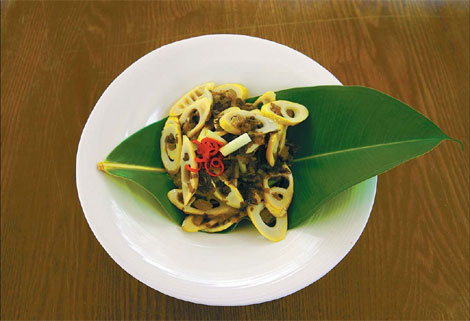Much ado about bamboo
Updated: 2012-04-07 07:43
By Ye Jun (China Daily)
|
|||||||||||
|
Fried bamboo shoots shredded with salted potherb mustard, called "Xuecai Chao Chunsun", is a dish often made at home and in restaurants in China. Photos by Ye Jun / China Daily |
Springtime is the best season to enjoy bamboo shoots. Ye Jun reports.
Spring has sprung, and bamboo sprouts are sprouting - to the delight of Chinese chefs. The spring shoots can now be found heaped alongside the last winter sprouts at markets. They hit Beijing's veggie markets on the 20th day of the lunar calendar's first month and will stay until May. They cost more than meat during the first days after Spring Festival.
The sprouts grow year-round, but springtime is the best time for baby bamboo. Emperors dined on this delicacy and poets penned its praises.
And these young sprigs are indeed versatile. They can be prepared for hot or cold dishes, sauteed, fried, boiled, sliced, diced, shredded and mashed - you name it.
The shoots' yellowish white hue can also enhance the dish's coloration. It works well shiomai, for instance, because its color matches the white of pork.
Classic soups with bamboo shoots include songsao yugeng, fish soup with bamboo pieces and eel slice soup with bamboo slices.
"There might be more than 1,000 Chinese dishes that include bamboo shoots," executive chef of Kong Yi Ji Restaurant's Houhai branch, Chen Qing says.
"It's a wild card in Chinese cuisine. It doesn't have much taste on its own but takes on that of other ingredients. The shoots go well with animal oil, such as from chicken, duck and pork."
The sprouts are also excellent at soaking up greasiness.
|
Baby bamboo is most delicious in spring. Tao Li / For China Daily |
Chen points out different regions cook shoots differently.
"But the ingredient is omnipresent and occupies a venerated place in all eight major Chinese cuisines," he says.
Bamboo shoots are widely available in China, especially in provinces south of the Yangtze River, such as Jiangsu, Zhejiang and Anhui. But other locales, such as Sichuan, Yunnan and Guizhou provinces, and the Guangxi Zhuang autonomous region, are known for their own varieties.
"China is home to more than 100 bamboo species," Chen says. "Even northern cities like Beijing have five or six edible types."
Bamboo shoots are to South China what cabbage is to the North, he explains.
They're salted and pickled in Guangxi, Guizhou and Yunnan. They're fried and smoked in Sichuan, where they're often stewed with fowl or pork. And the sprouts are dried around the country.
Kong Yi Ji's cuisine is Zhejiang's Shaoxing style. Bamboo shoots are a must at any banquet in Jiangsu and Zhejiang provinces.
One popular pick at Kong Yi Ji is blanched hand-shredded bamboo shoots. Diners get to play with their food as they peel off the hard outsides.
Another Kong Yi Ji specialty is oil-braised shoots. They're first fried and then boiled in soy sauce, oyster oil and yellow rice liquor.
Yanduxian, originally from Shanghai cuisine, is a soup of spring shoots with fresh and salted pork slices. In another favorite, bamboo and old duck are boiled together to concoct a milky-white soup.
Da Dong Peking Roast Duck Restaurant owner and chef Dong Zhenxiang recalls fried chicken slices with yulanpian bamboo was a money-spinner when he started cooking in the 1980s.
"Yulanpian'" refers to dried bamboo shoots boiled repeatedly in rice soup to give a whitening effect, resembling beautiful yulan flower petals.
Dong recorded on his blog his recent trip to the bamboo forest of Tianmu Mountain in Zhejiang province's Lin'an, where he dug the first spring shoots after Spring Festival.
He compares the acerbity of bamboo shoots to the immaturity of boyhood and their sweetness to that of the tenderest pear's.
Dong believes it's the sensation between the teeth that makes bamboo so special.
"The spring sprout's freshness and purity comes from the fact that the earth has nurtured the shoots for the entire winter," he says.
His restaurant serves the shoots boiled and chilled on ice with a winter plum blossom in a dish called "plum blossoms in the snow", during the colder months. Bamboo leaves replace the blossoms in springtime.
Spring bamboo shoots are packed with vegetal protein, calcium, phosphorous and ferrous. They're also high in coarse fiber but low in fat and starch.
Traditional Chinese medicine holds that bamboo shoots nourish yin, dispel phlegm, benefit circulation and enhance vision.
Many bamboo sprout dishes are easy to make at home.
Beijing housewife Han Ping says the secret to oily braised bamboo is to treat it like meat.
But bamboo must be boiled for five to 10 minutes to purge its acerbity and eliminate oxalic acid, a substance that brings bad news to people with stones in their kidneys, gallbladders or urethras.
Chen says bamboo shoots are an icon of Chinese cuisine overseas.
"Chinese and Western cuisines share such ingredients as meats and seafood," he says.
"But bamboo is uniquely Chinese. Its position in Chinese cuisine is equal to sushi's in Japanese food."
Today's Top News
Rescuers race against time for quake victims
Telecom workers restore links
Coal mine blast kills 18 in Jilin
Intl scholarship puts China on the map
More bird flu patients discharged
Gold loses sheen, but still a safe bet
US 'turns blind eye to human rights'
Telecom workers restore links
Hot Topics
Lunar probe , China growth forecasts, Emission rules get tougher, China seen through 'colored lens', International board,
Editor's Picks

|

|

|

|

|

|







